Establishing Routines for Remote Learning
 Photo by August de Richelieu from Pexels
Photo by August de Richelieu from Pexels
Teaching students how to interact online helps ensure a good experience for both students and teachers.
- 0 Comments
- Sep 15, 2020 10:00:00 AM
- Posted by Natalia Galvis
- Topics: EdTech, STEM, Curriculum, teachers, students, Technology, Edchat, Digital Technology, teaching, online, lessons, eLearning
5 Reasons to Teach Students 3D-Tech Skills
3D technology, while not necessarily new, has taken off in recent years. Workers in industries like architecture and design use 3D tech skills to bring their visions to life. 3D printing is one of the more popular aspects of this innovation, but educators can teach students several others — for any grade level from kindergarten through college.
 Photo by ThisIsEngineering from Pexels
Photo by ThisIsEngineering from Pexels
These five reasons show the benefits of teaching students 3D skills.
- 0 Comments
- Sep 11, 2020 10:00:00 AM
- Posted by Natalia Galvis
- Topics: EdTech, STEM, Curriculum, teachers, students, Technology, Edchat, Digital Technology, teaching, online, lessons, eLearning
Benefits of Technology in the Classroom

As we sail through the 21st century, technology in the classroom is becoming more and more predominant. Tablets are replacing our textbooks, and we can research just about anything that we want to on our smartphones. Social media has become commonplace, and the way we use technology has completely transformed the way we live our lives.
Educators, too, have seen firsthand the benefits of technology in the classroom. They also recognize the importance of developing these technological skills in students so they will be prepared to enter the workforce once they complete their schooling.
- 0 Comments
- Feb 17, 2020 10:10:00 AM
- Posted by Natalia Galvis
- Topics: EdTech, STEM, 21st Century Classroom, teachers, Robots,, Technology, Elementary, STEMchat, Edchat, Digital Technology
EdTech Trends 2020: the future is now

The end of a year and the start of a new one is the ideal time to reflect on the recent changes in the field of education technology and to look to the immediate future of technological solutions for the classroom: what does the beginning of the new decade have in store for students and teachers worldwide?
- 0 Comments
- Jan 10, 2020 10:00:00 AM
- Posted by Natalia Galvis
- Topics: Robotics, EdTech, STEM, Technology, Innovation, Edchat, AI, Digital Technology
What Does a Future Ready Educator Look Like?

As new technology emerges and most work is done online, it is more important than ever to teach students how to adapt in the ever-changing digital world they live. This is where “Future Ready” schools and “Future Ready” educators become essential.
The Alliance for Excellent Education describes, “Future Ready is a free, bold new effort to maximize digital learning opportunities and help school districts move quickly toward preparing students for success in college, a career, and citizenship.” As school districts invest in developing Future Ready schools, educators must also make sure they are preparing to embrace digital learning to be “future ready” educators. What does this look like?
- 1 Comments
- Jan 8, 2020 10:00:00 AM
- Posted by Natalia Galvis
- Topics: Robotics, EdTech, STEM, teachers, Technology, Edchat, Digital Technology, Educators
Coding, Robotics and the Jobs of the Future

Since as early as the 1800’s, fears of robots taking over human jobs has been a reality. As we enter the true age of robotics, those concerns are resurfacing, and educators are unsure about what jobs their students will be competing for. For example, IT jobs will grow by 22% through 2020 and jobs in STEM are said to see similar growth. Educators are expected to equip their students with skills that will translate into careers and yet they have no idea what these skills should be. While timeless skills such as critical thinking, languages and mathematics aid in every career they do not provide the specialized skills that “jobs of the future” may require. So, what are the jobs of the future and how can be best prepare students for them?
- 0 Comments
- Jan 7, 2020 10:00:00 AM
- Posted by Natalia Galvis
- Topics: Robotics, EdTech, STEM, Artificial Intelligence, Technology, Edchat, AI, Digital Technology
5 Big Ed-Tech Problems to Solve in 2020

Teaching Artificial Intelligence. Moving beyond coding when talking about computer science. Training teachers to use technology without having to get certified by a big company.
Those are among the five education technology issues that Ricard Culatta, the CEO of the International Society for Technology in Education, thinks educators should watch in the 2020 school year.
- 0 Comments
- Jan 6, 2020 12:01:09 PM
- Posted by Natalia Galvis
- Topics: EdTech, STEM, Technology, Edchat, Digital Technology
3 Reasons Why Schools Must Encourage Technology Use

Schools and technology use have been inseparable for decades. How we use technology is changing.
The 21st century requires skills far different than those of the last century. Today’s workforce incorporates technology in nearly every aspect of their jobs and lives. Digital computing not only assists in task completion but in many cases, it has taken over repetitious duties. Technology also allows people to conduct professional and personal business on the go. We work, bank, socialize, learn, and entertain ourselves online.
Our students are growing up in a digitally connected world. They’ve never known anything else. As of June 2019, an estimated 7.7 billion people accessed the internet for labor and leisure purposes. That number is expected to grow as internet penetration expands throughout the world.
To prepare students for living and working in a quickly-evolving world that centers around technology, we must provide differentiated support, teach collaboration skills, and make learning fun. Technology makes those goals possible.
- 0 Comments
- Jan 3, 2020 10:30:00 AM
- Posted by Natalia Galvis
- Topics: EdTech, STEM, Technology, Edchat, Digital Technology
Developing Critical Thinking through education technology

Critical thinking is not a school subject, but if taught properly, it will help students in their future endeavours whether they intend to continue to higher education or to enter the workforce immediately after K-12. It is not a single skill, either, but rather a set of different skills working together to allow students to process information, make evaluations, solve problems, and come up with innovative ideas rather than relying without question on what they have been told. In short, critical thinking will prove useful to students not just at school, but in life in general.
Just like it has transformed the teaching of traditional subjects, EdTech can leave a mark on the development of critical thinking too: let’s see how.
- 0 Comments
- Dec 30, 2019 10:00:00 AM
- Posted by Natalia Galvis
- Topics: EdTech, STEM, Technology, Edchat, Digital Technology
Technology Collaboration Results in Improved Success

The key to any success lies in collaboration. With vision and persistence, people can set goals and inspire others to join in pursuit of them.
Katie Bouman recently shook up the world of physics. She developed the algorithm that would enable them to triangulate image points in a collaborative effort to take a picture of a black hole. The Event Horizon Telescope was not launched in a silo, and Bouman didn’t work alone. Bouman led the competent teams stationed around the world in capturing the first image of a black hole. Her need to collaborate didn’t lessen her achievement; it made it even more notable.
The black hole imaging project is not the first collaborative effort that integrated technology. The Human Genome Project and the Millennium Seed Bank Partnership are also global efforts to better understand our environment and improve the quality of life for everyone. Successful technology integration depends on collaboration.
The same is true for edtech.
- 0 Comments
- Dec 27, 2019 10:30:00 AM
- Posted by Natalia Galvis
- Topics: EdTech, Technology, Edchat, Digital Technology
Relevant Posts
Popular Posts
Subscribe to Email Updates
-
I Want To Learn MoreADDITIONAL INFORMATION


